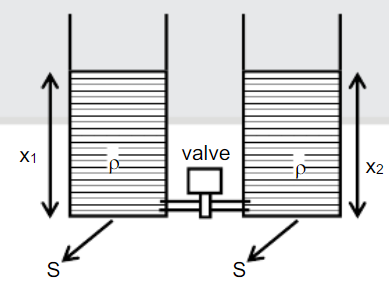A long cylindrical metal vessel, having a linear coefficient (α), is filled with a liquid upto a certain level. On heating , it is found that the level of liquid in the cylinder remains the same. What is the volume coefficient of expansion of the liquid?
As the level of the liquid inside the vessel remains the same, irrespective of heating the vessel, therefore, the volume coefficient of expansion of the liquid is same as the volume coefficient of expansion of the vessel which is γ=3α
Topper's Solved these Questions
- THERMAL PROPERTIES OF MATTERBOOK - MODERN PUBLICATIONCHAPTER - THERMAL PROPERTIES OF MATTEREXERCISE - TOUGH AND TRICKY PROBLEM
10 Videos
- THERMAL PROPERTIES OF MATTERBOOK - MODERN PUBLICATIONCHAPTER - THERMAL PROPERTIES OF MATTEREXERCISE - NCERT FILE (TEXTBOOK EXERCISE)
25 Videos
- THERMAL PROPERTIES OF MATTERBOOK - MODERN PUBLICATIONCHAPTER - THERMAL PROPERTIES OF MATTEREXERCISE - PRACTICE PROBLEM
28 Videos
- SYSTEMS OF PARTICLES AND ROTATIONAL MOTIONBOOK - MODERN PUBLICATIONCHAPTER - SYSTEMS OF PARTICLES AND ROTATIONAL MOTIONEXERCISE - Chapter Practice Test (for Board Examination)
16 Videos
- UNITS AND MEASUREMENTBOOK - MODERN PUBLICATIONCHAPTER - UNITS AND MEASUREMENTEXERCISE - CHAPTER PRACTICE TEST
15 Videos
Similar Questions
A long cylindrical metal vessel, having a linear coefficient (α), is filled with a liquuid upto a certain level. On heating it, it is found that the level of liquid in the cylinder reamains the same. What is the cylinder reamains the same. What is the volume coefficient of expansion of the liquid?
View SolutionFind the loss in gravitational potential energy of cylinder when value is opened and level of liquid in both cylinder becomes same

View Solution
Knowledge Check
A long cylindrical metal vessel of volume V and coefficient of linear expansion α contains a liquid. The level of liquid has not changed on heating. The coefficient of real expansion of the liquid is.
AV−αVBV+αVCVV−αD3αThe ratio of coefficients of apparent expansions of the same liquid in two different vessels is 1:2. If α1 and α2 are the coefficient of linear expansions then coefficient of real expansion of the liquid is
A2α1−α2B3α1−4α2Cα1−2α1D6α1−3α2The coefficient of apparent expansion of a liquid in a copper vessel is C and in a silver vessel S. The coefficient of volume expansion of copper is γC. What is the coefficient of linear expansion of silver
A(C+γC+S)/3B(C−γC+S)/3C(C+γC+S)/3D(C−γC−S)/3
If on heating a liquid through 800C, the mass explled is 1100th of mass till remaining, the coefficient of apparent expansion of the liquid is
View SolutionA cylindrical vessel of radius r is filled with a homogeneous liquid upto a height h. It is found that the force exerted by the liquid column on the bottom of the cylinder is equal to the force exerted by the liquid on the sides of the cylinder. What is the relation between r and h?
View SolutionIf on heating liquid through 80∘C, the mass expelled is (1100)thof mass still remaining , the coefficient of apparent expansion of liquid is
View SolutionOn heating a liquid having coefficient of volume expension α in a container having coefficient of linear expansion α/2, the level of the liquid in the container would
View SolutionOn heating a liquid of coefficient of cubical expansion γ in a container having coefficient of linear expansion γ/3. The level of liquid in the container will
View Solution
